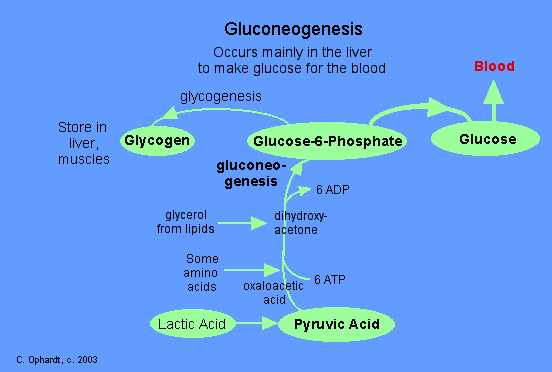

Metabolic Pathways
Welcome to the world that man attempts to cease with the creation of synthetically made products. Those creations simutaneously lead back to the intricacy of body's pathways that serve as essentials to our daily commodities.

Your Body's Metabolism
The metabolism can be specified as chemical changes, resulting from the sum of thousands of chemical reactions, that involves the use of energy in order to keep the cell living healthy. These chemical changes that occur within the body can be categorized into Catabolic reactions or Anabolic reactions.
Catabolism: Is a form of decomposition reaction that breaks down organic compounds into a simpler unit and releases energy during this process. The organic compounds typically broken down include: carbohydrates, lipids, proteins, and nucleic acids. Catabolic reactions manufacture more energy than they utilize.
* In short, in a catabolic reaction energy is released during the decomposition of complex molecules into simpler units.
Examples: Oxidation, Digesting Food, and Breaking down stored fats
Anabolism: Is a form of synthesis reaction that combines atoms and/or simple molecules into greater complex molecules and requires energy. They synthesize biomolecules such as biopolymers (glycogen, proteins, and nucleic acid) and complex lipids. The energy used by these reactions are subsequently supplied by catabolic reactions.
* So in short, an anabolic reaction requires energy and thus during a reaction it will consume this energy to synthesize complex molecules.
Examples: Synthesizing Proteins and Replicating DNA

The reactions of anabolism and catabolism, in addtion to the breakdown of ATP to ADP, heat energy, and inorganic phosphate. (Image Citation)

Catabolic pathways are responsible for breaking down molecules containing nutrients as illustrated in A,B, & C to be created into a usable form and either be released as heat or stored as energy in molecules. Anabolic pathways in turn build more complex molecules from the products of catabolic pathways through the consumption of energy. This is demonstrated with figures D,F & E. (Image Citation)
The Roads of the Human Body: Metabolic Pathways
Metabolic pathways can be defined as a series of consecutive chemical reactions within a cell, catalyzed by enzymes to produce specific product. These pathways consist of a band of characteristics portraying their unique qualities: 1) Metabolic pathways are in fact irreversible; 2) All pathways contain the first comitted step; 3) They are regulated; and 4) They reside within the boundaries of the eukaryotic cell and occur in specific cellular locations.
The Major Metabolic Pathways

A colorful demonstration depicting the highly common pathways. (Image Citation)
There are way over a thousand metabolic pathways between plants and animals, but only a handful serve important functions within the human body.
Glycolysis:
Glycolysis the catabolic decomposition of glucose accomplished anaerobically or without the means of oxygen. It occurs in the cytoplasm of a eukaryotic cell.

Click on the video on the right to learn an in depth knowledge of glycolysis!
Regulation of Glycolysis-
- Hormones
- Allosteric regulators
- Energy charge
- Fructose 2,6-biphosphate
Do you want a clearer, more concise explanating regarding glycolysis? Click on the picture on the left and watch the animation demonstrated. Test your knowledge once you've finished!
Gluconeogenesis:
Gluconeogenesis is the process of creating glucose through non-carbohydrates. Its main occurence is in the liver and occasionally in the kidney, brain, skeletal muscles, heart muscles, or other body tissue.
Regulation of Gluconeogenesis -
- Hormones
- Allosteric Regulators
- Energy charge
- Fructose 2,6-biphosphate

A diagram showing the process of Gluconeogenesis. (Image Citation)
Citric Acid Cycle:
The Citric Acid Cycle also commonly referred to as the Kreb's Cycle or Tricarboxylic Acid Cycle (TCA) is a catabolic process that requires the use of oxygen; it occurs in the mitochondria.
Watch the animationbelow for an extensive overview of the Citric Acid Cycle!
So What's the Point?
As you were reading, the following thought must have crossed your mind at some point - what's the point in even discovering these pathways? It is true, upon first impression, none of this information seemed to be relevant or even seemed to share a greater pur pose. But here's a secret, without the discovery of these pathways, almost none of the things we have in our modern world today would be present.
1. Herbicides - Herbicides are a group of products that were invented with the knowledge of these metabolic pathways in hand. Recollect every time you saw your parents spray their plants with a bottle of chemicals, or every time you saw a small duster plane soar over a field of crops spraying some sort of liquid as it flew. This was all made possible with the knowledge of these pathways at hand.
2. Insecticides - When you see a cockroach in your room, what is your first action if you have not already killed it or thrown it out? It is to pull out a can of bug spray and to coat it with the liquid till your satisfied that it died. These insecticides were created with the insight of pathways. And not only have they been used to just destroy nuisances, they were utilized in getting rid of diseases such a malaria.
3. Biological Wafare - Who would have guessed that a few measly pathways found within the body with serve as an explosive tool in the combat of war? Well certainly not the scientists who discovered them as they witnessed their use in World War II and the Vietnam War.
4. Pharmaceuticals - Did you know that every medicine you've ever taken in your entire existance was designed with the knowledge of these metabolic pathways? Without the use of the pathways discovered, scientists wosuld not be able determine which enzymes and protein to inhibit or increase to create an efficient treatment for a disease such as Parkinson's or HIV.
Keep on reading if you would like to learn more about the use of these applications in regards to metabolic pathways!

Home
